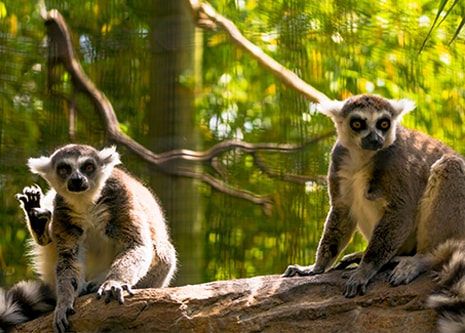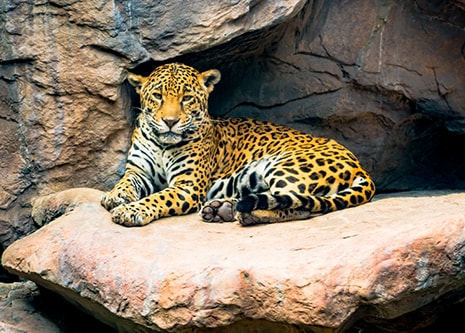
- VisitSupport Happy HollowDONATE TODAYExploreSupport Happy HollowDONATE TODAYLearnSupport Happy HollowDONATE TODAYSupport
-
Today's Hours: 10:00 am to 5:00 pm
Education AmbassadorsLeopard gecko

Scientific name: Eublepharis macularius
Family: Gekkonidae
Order: Squamata
Class: Reptilia
Range: Southern Asia: Pakistan, Northern India, Afghanistan
Habitat: Desert, Grassland Lifespan: Unknown in the wild; up to 25 years in captivityWhat do they look like?
Leopard geckos are 7 to 10 inches long at maturity with relatively large heads, big eyes and slender toes. They are yellow-bodied with light lavender tails and have black spots which give them their name. Their tails serve as fat storage, plumping during times of plenty and thinning during the dry season. Most of their scales are small and skin-like in texture; however, rows of larger, bumpy scales are dispersed in between to mimic rock and sand texture. Leopard geckos belong to a small group of geckos that possess eyelids. Unlike most of their close relatives, these geckos do not have setae, the foot pads that allow most geckos to climb on smooth surfaces. Instead, they have small toes tipped with little claws. This adaptation helps them to climb and crawl in their rocky environment.How do they behave?
Leopard geckos are nocturnal (mainly active at night) preferring to avoid hot temperatures during the day. They are also ectothermic (they rely on their surrounding temperature to regulate body functions). Leopard geckos spend their days in burrows or under rocks to stay cool. During summer, they may even estivate (stay dormant during prolonged hot weather) in order to avoid extreme temperatures. Like other geckos, leopard geckos can voluntarily drop their tails to escape an encounter with a predator. The lizard’s nervous system sends a signal to release the muscles around the base of the tail. The muscles of the dropped portion of the tail contract rapidly and the tail twitches around while the lizard escapes. However, due to the importance of the nutrition stored in tails of leopard geckos, this is a last resort.What do they eat?
In the wild, leopard geckos eat other small lizards, insects and arachnids. At Happy Hollow, they eat crickets and mealworms.How are they born?
Leopard geckos reach sexual maturity at one to two years of age. Like most other reptiles, leopard geckos are oviparous (egg-layers). Female leopard geckos can lay up to five clutches of two eggs per breeding season, which lasts from January through September. Eggs are buried then left to incubate on their own. The eggs will hatch approximately two months later. The sex of the babies depends on the incubation temperature. Lower temperatures result in mostly females while higher temperatures result in mostly males.Conservation
Leopard geckos are common throughout their range in Southern Asia and their conservation status is listed by the International Union for Conservation of Nature as Least Concern. Wild populations of leopard geckos are currently stable, however excessively catching leopard geckos for the pet trade could lead to a threatened status. Wild-caught animals will often refuse to eat in captivity and can carry parasites. Poor conditions of importation often lead to stressed and aggressive animals. If you would like to help leopard geckos, do not support the illegal pet trade by purchasing wild-caught lizards. Make sure potential pets are captive-bred in the United States rather than being imported from Africa. If you are considering a leopard gecko as a pet, make sure to do your research and consider adopting from your local animal shelter or reptile rescue group. For more information on reptile rescue in the Bay Area check out the Bay Area Amphibian and Reptile Society at www.baars.org
Zoo on the Hill
Located across from the Keep-Around Carousel is the Zoo on the Hill. Learn about wildlife up close during daily meet-and-greets, leap like a lemur on the playground, brush and feed the goats,, or take a peek inside Doc’s Critter Care building and the Ranch House. Double-H Ranch features a combination of animal exhibits, including giant anteaters and red ruffed lemurs, as well chickens and domesticated animals that are docile enough to touch.

Zoo in the Hollow
Follow the crooked bamboo pathway down into the hollow and visit with some of the most amazing animals in the world. Where else in San José can you get up close to a stunning jaguar, lemur, meerkat or American alligator? Happy Hollow is dedicated to helping save species and preserve wildlife for future generations by participating in Species Survival Plan programs through the Association of Zoos and Aquariums.